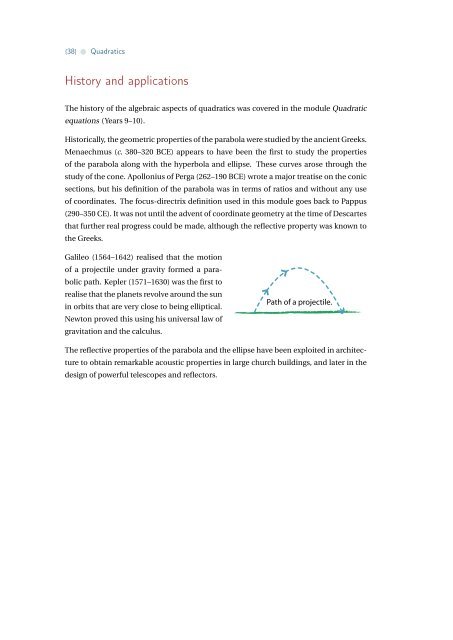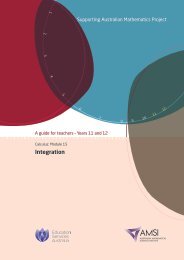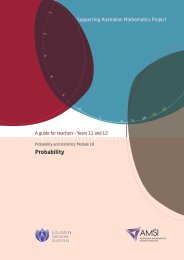Quadratics - the Australian Mathematical Sciences Institute
Quadratics - the Australian Mathematical Sciences Institute
Quadratics - the Australian Mathematical Sciences Institute
Create successful ePaper yourself
Turn your PDF publications into a flip-book with our unique Google optimized e-Paper software.
{38} • <strong>Quadratics</strong><br />
History and applications<br />
The history of <strong>the</strong> algebraic aspects of quadratics was covered in <strong>the</strong> module Quadratic<br />
equations (Years 9–10).<br />
Historically, <strong>the</strong> geometric properties of <strong>the</strong> parabola were studied by <strong>the</strong> ancient Greeks.<br />
Menaechmus (c. 380–320 BCE) appears to have been <strong>the</strong> first to study <strong>the</strong> properties<br />
of <strong>the</strong> parabola along with <strong>the</strong> hyperbola and ellipse. These curves arose through <strong>the</strong><br />
study of <strong>the</strong> cone. Apollonius of Perga (262–190 BCE) wrote a major treatise on <strong>the</strong> conic<br />
sections, but his definition of <strong>the</strong> parabola was in terms of ratios and without any use<br />
of coordinates. The focus-directrix definition used in this module goes back to Pappus<br />
(290–350 CE). It was not until <strong>the</strong> advent of coordinate geometry at <strong>the</strong> time of Descartes<br />
that fur<strong>the</strong>r real progress could be made, although <strong>the</strong> reflective property was known to<br />
<strong>the</strong> Greeks.<br />
Galileo (1564–1642) realised that <strong>the</strong> motion<br />
of a projectile under gravity formed a parabolic<br />
path. Kepler (1571–1630) was <strong>the</strong> first to<br />
realise that <strong>the</strong> planets revolve around <strong>the</strong> sun<br />
in orbits that are very close to being elliptical.<br />
Newton proved this using his universal law of<br />
gravitation and <strong>the</strong> calculus.<br />
Path of a projectile.<br />
The reflective properties of <strong>the</strong> parabola and <strong>the</strong> ellipse have been exploited in architecture<br />
to obtain remarkable acoustic properties in large church buildings, and later in <strong>the</strong><br />
design of powerful telescopes and reflectors.
















